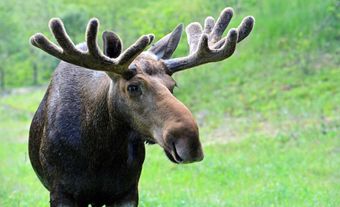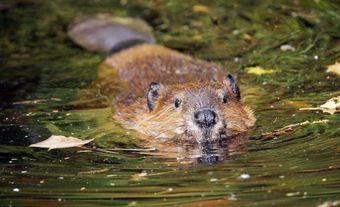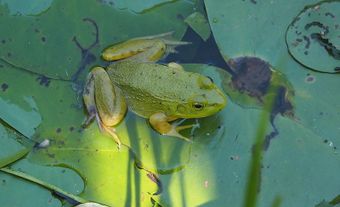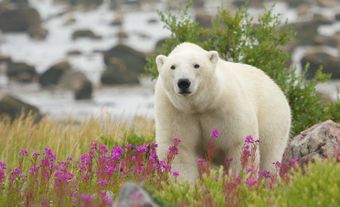Squirrels are rodents of the widespread family Sciuridae, which includes species such as chipmunks, ground squirrels and marmots. Approximately 285 species of squirrel have been found worldwide, from the Americas to Eurasia and Africa. In Canada, 23 species occur, all of which are native. Of these 23 species, six are tree-dwelling squirrels (two of which are flying squirrels) and 17 are ground-dwelling squirrels (seven of which are ground squirrels, five of which are chipmunks, four of which are marmots and one of which is a prairie dog). Squirrels are closely related to mountain beavers and dormice (suborder Sciuromorpha).

Squirrel Species in Canada
|
Common Name |
Scientific Name |
Provinces/Territories |
|
American red squirrel |
Tamiasciurus hudsonicus |
|
|
Urocitellus parryii |
MB, SK, BC, YK, NWT, NU |
|
|
Black-tailed prairie dog |
Cynomys ludovicianus |
SK |
|
Cascade golden-mantled ground squirrel |
Callospermophilus saturatus |
BC |
|
Columbian ground squirrel |
Urocitellus columbianus |
AB, BC |
|
Douglas’ squirrel |
Tamiasciurus douglasii |
BC |
|
Eastern chipmunk |
Tamias striatus |
NL, NS, NB, PEI, QC, ON, MB, SK |
|
Eastern gray squirrel |
Sciurus carolinensis |
ON, MB, SK, BC |
|
Fox squirrel |
Sciurus niger |
SK, MB, ON, QC, NB |
|
Franklin’s ground squirrel |
Poliocitellus franklinii |
ON, MB, SK, AB |
|
Golden-mantled ground squirrel |
Callospermophilus lateralis |
AB, BC |
|
Groundhog |
Marmota monax |
NL, NS, NB, QC, ON, MB, SK, AB, BC, YK, NWT |
|
Hoary marmot |
Marmota caligata |
AB, BC, YK, NWT |
|
Least chipmunk |
Neotamias minimus |
ON, MB, SK, AB, BC, YK, NWT |
|
Northern flying squirrel |
Glaucomys sabrinus |
NL, NS, NB, PEI, QC, ON, MB, SK, AB, BC, YK, NWT, NU |
|
Red-tailed chipmunk |
Neotamias ruficaudus |
AB, BC |
|
Richardson’s ground squirrel |
Urocitellus richardsonii |
MB, SK, AB |
|
Southern flying squirrel |
Glaucomys volans |
NS, NB, QC, ON |
|
Thirteen-lined ground squirrel |
Ictidomys tridecemlineatus |
MB, SK, AB |
|
Townsend’s chipmunk |
Neotamias townsendii |
BC |
|
Yellow-bellied marmot |
Marmota flaviventris |
SK, AB, BC |
|
Yellow-pine chipmunk |
Neotamias amoenus |
AB, BC |
|
Vancouver Island marmot |
Marmota vancouverensis |
BC |

Description
Squirrels are small- to medium-sized terrestrial rodents. All squirrels have four toes on the forefeet and five toes on the hind feet.
Tree squirrels are characterized by bushy tails, which play a crucial role in communication, and small feet. Unlike most mammals, they can descend trees headfirst. They can do so by rotating their ankles 180 degrees, allowing their hind feet to point backward up the tree and thus grip the bark from the opposite direction. Flying squirrels, a subset of tree squirrels, have a skin fold along their flanks connecting their forelegs with their hind legs. This membrane allows them to glide between trees. Flying squirrels are also the only nocturnal squirrel species in Canada. Tree squirrels remain active year-round and do not hibernate. Tree squirrels frequently build nests, called dreys, in trees.
Ground-dwelling species typically have less bushy tails and more robust hind feet. Ground squirrels and chipmunks are known for their ability to carry food in internal cheek pouches. Eastern chipmunks have been found with six chestnuts in their cheek pouches or as many as 31 kernels of corn. Ground-dwelling squirrels also display a large range of sizes, with the largest being the hoary marmot, which is 80 cm long and weighs 6 kg, and the smallest being the least chipmunk, which is 22 cm long and weighs 50 g. Ground-dwelling squirrels typically hibernate or enter torpor during the winter and dig burrows for shelter and food storage. Some ground squirrels, like the black-tailed prairie dog, can be very social and live in colonies.
Did you know?
Black squirrels, as they are frequently called, are not actually a species of squirrel. In fact, black squirrels are simply the melanistic morph of Eastern gray squirrels and fox squirrels, which is to say they have increased amounts of melanin in their coat compared with the greyer individuals of the same species.

Distribution and Habitat
Squirrels can be found throughout Canada. Certain species, such as the American red squirrel, are widespread in boreal and mixed forests in all provinces and territories. Other species, like the Vancouver Island marmot, are only found in very small and specific locations.
Different species of squirrels thrive in different habitats, ranging from boreal forests to deciduous forests, prairies, mountains, arctic regions and even urban landscapes. Squirrels can also have variable home ranges. Ground squirrels may have a home range of between 0.6–4 hectares. Eastern chipmunks have home range sizes ranging from 100 m2 to 1 hectare, depending on food availability.
Did you know?
One of the squirrel species found in Canada, the Vancouver Island marmot, is endemic to Canada, meaning that it can only be found in Canada. This marmot is critically endangered, with only about 250 individuals in the wild as of 2021.

Reproduction and Development
In Canada, most species of squirrels reproduce once annually, with the exact timing being species and even environmentally specific. Eastern gray squirrels and American red squirrels, for example, have two breeding seasons, one in the winter and one in the summer, resulting in offspring born either in the spring or fall, respectively. When food is very plentiful, such as during a mast year, a female may breed during both breeding seasons. Many squirrels also appear able to predict these mast years and will amp up reproduction in anticipation of this food abundance.
Did you know?
Many species of trees (e.g., beech, maple, spruce) will synchronize their seed production in what is known as a mast year in an attempt to flood the ecosystem with so many seeds that the seed predators are unable to eat them all, and some will make it to germination. These mast years may come every one to two years, as with beech and maple trees in southern Quebec, or every three to seven years, as with white spruce trees in the Yukon.
Many squirrel species, including Eastern gray squirrels, American red squirrels and Eastern chipmunks, have a scramble competition mating system. In this system, a given female will go into estrus for a day, and males will pursue her and compete with one another to secure the ability to mate with her. Males may travel quite far in order to participate in these mating chases.
Other species, such as the more social ground squirrels, may instead establish a male hierarchy and the right to mate primarily through wrestling matches.
Gestation typically lasts 24–44 days, and litters average three to eight young, depending on species. At birth, the young are hairless and poorly developed; their growth is rapid.

Diet and Predation
Squirrels are primarily herbivorous, mostly relying on green vegetation, nuts, seeds, bulbs and buds. However, most squirrels will gladly eat insects, eggs, small birds and mammals.
Squirrels hoard and cache food for a later time. Some species, like the Eastern gray squirrel and the fox squirrel, are scatter-hoarders and will bury seeds and nuts all around their home range. Others, like the red squirrel, are larder-hoarders and will cache cones and other food items in mounds within their territory. This sizeable central cache often results in a midden, which is a visible mound of discarded food remains.
Squirrels are eaten by most medium-to-large predators in the areas they inhabit. While very fast, they can make up a significant portion of the diet of foxes, lynx, mustelids, rattlesnakes and various birds of prey. In certain areas, squirrels, especially ground squirrels, are also hunted by humans.

Ecological Importance and Relationship with Humans
Many squirrels play a very important role in their ecosystems. Eastern gray squirrels and American red squirrels are ecologically essential natural forest regenerators. By burying or hoarding seeds across the forest and frequently not returning to eat those seeds, they plant countless trees every year, helping the forest regenerate. Ground squirrels, for their part, are critical for their role in soil aeration by borrowing, helping address soil compaction and assisting with plant growth.
As cities have encroached on natural spaces, many species of squirrels, most notably the Eastern gray squirrel, have learned to thrive in urban environments. Species that thrive in human environments and have lost much of their fear of humans are known as synanthropic. In these urban landscapes, squirrels occasionally earn a bad reputation for damaging cereal crops, bird feeders and garbage bins in their quest for food.

Status and Threats
While most species of squirrels found in Canada are listed as Species of Least Concern by the IUCN Red List, one species, the Vancouver Island marmot, is critically endangered. With only two subpopulations left, a total of about 250 individuals, less than 10 km2 of viable habitat combined and continued deforestation, they are at a very high risk of extinction within the foreseeable future. In 2003, only 30 wild marmots remained. Conservation efforts continue, but much work remains to be done to preserve the species.


 Share on Facebook
Share on Facebook Share on X
Share on X Share by Email
Share by Email Share on Google Classroom
Share on Google Classroom








